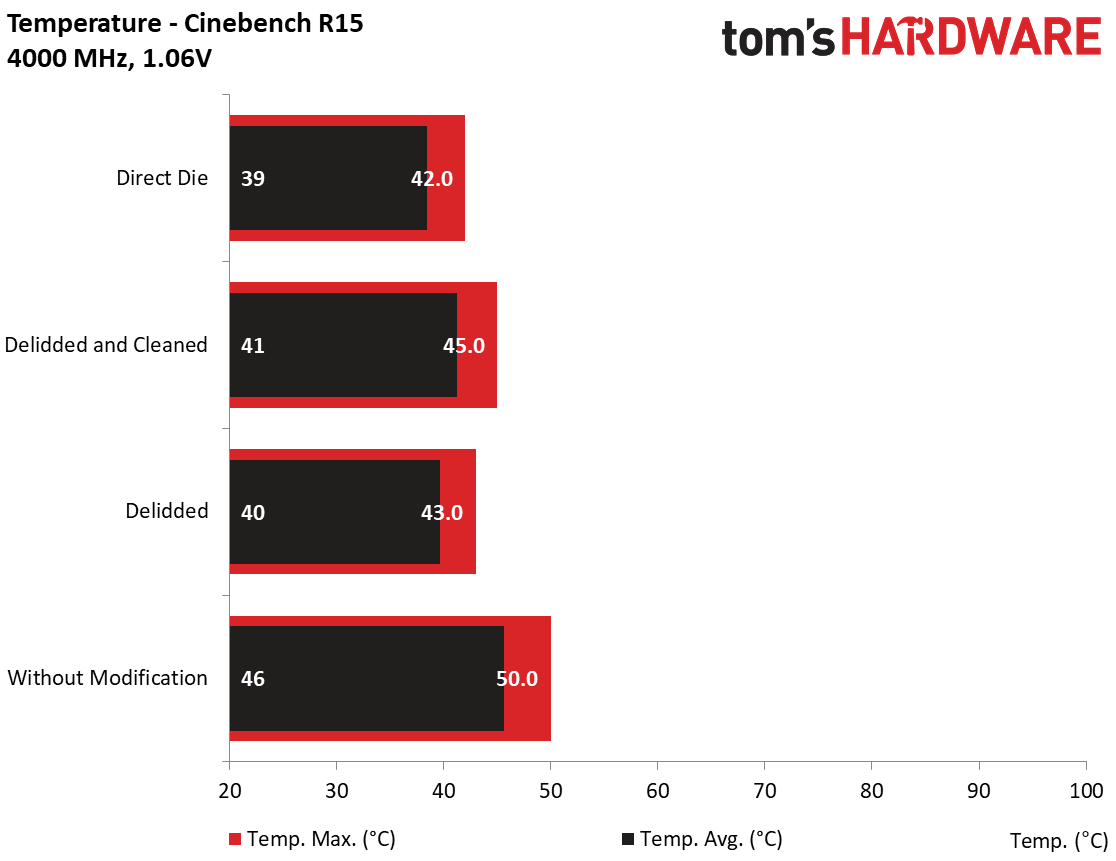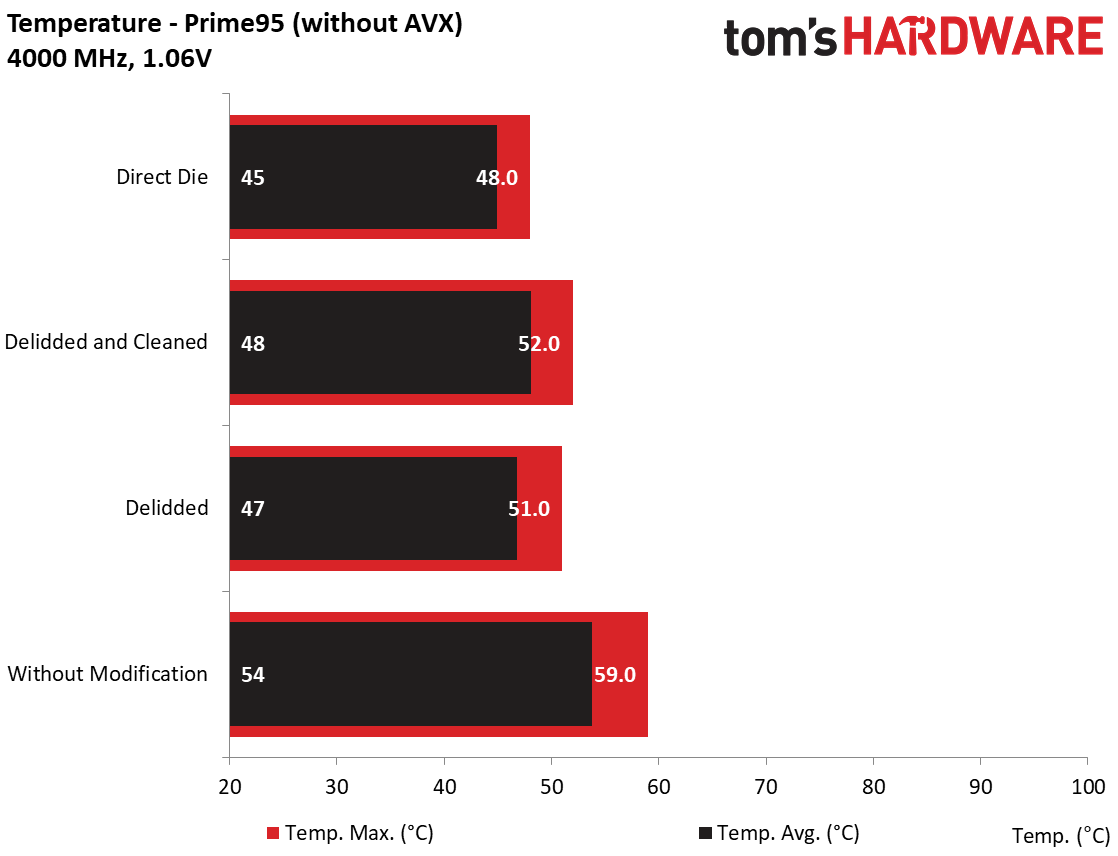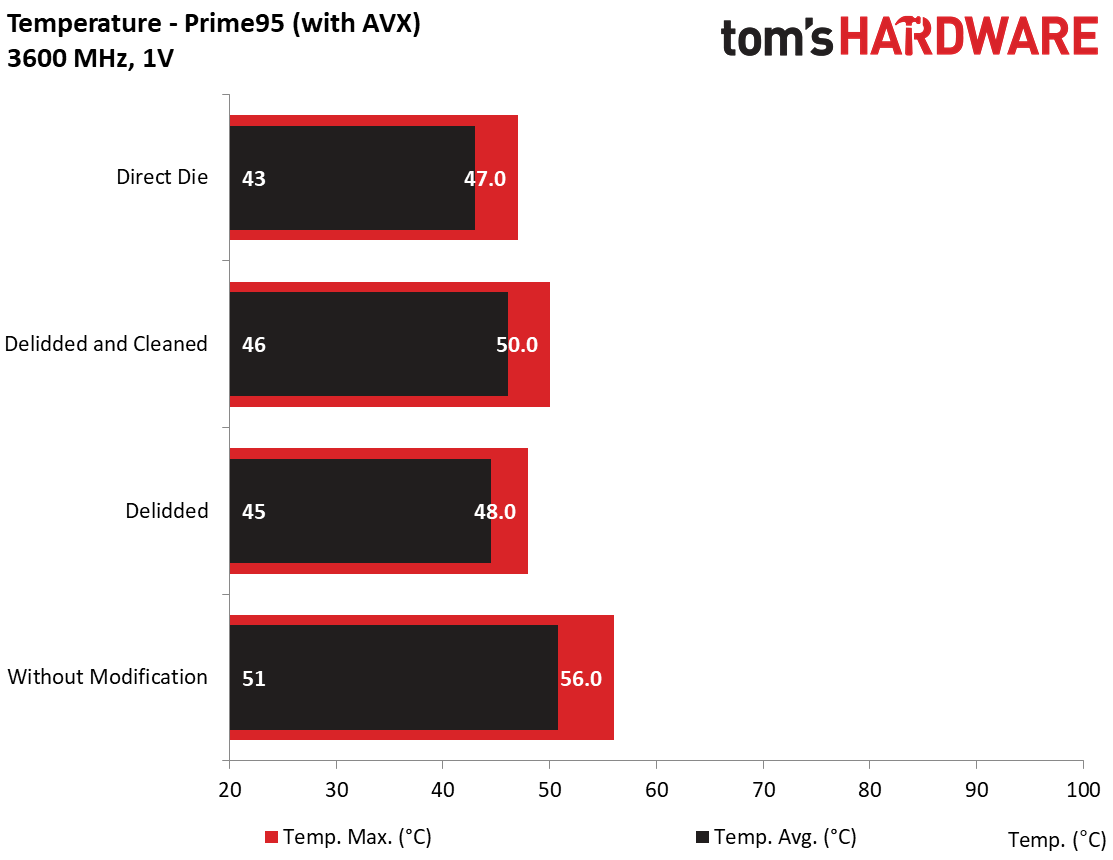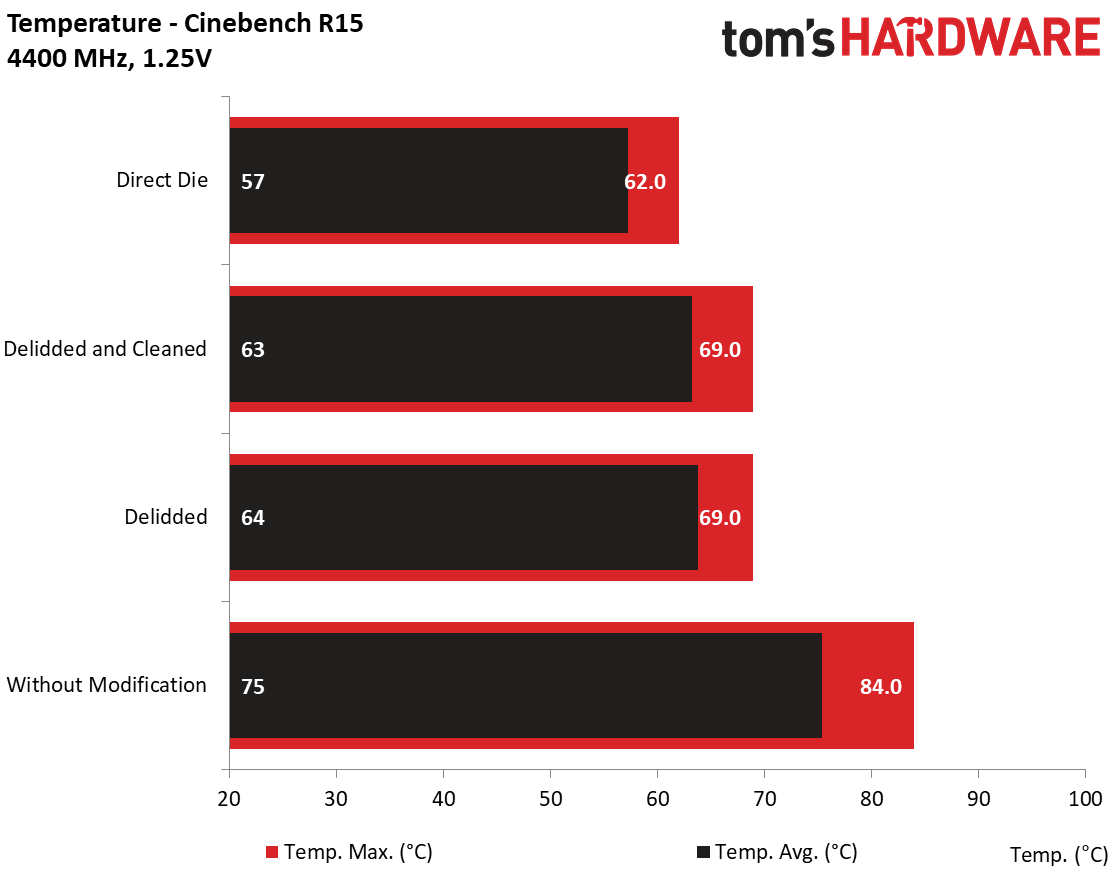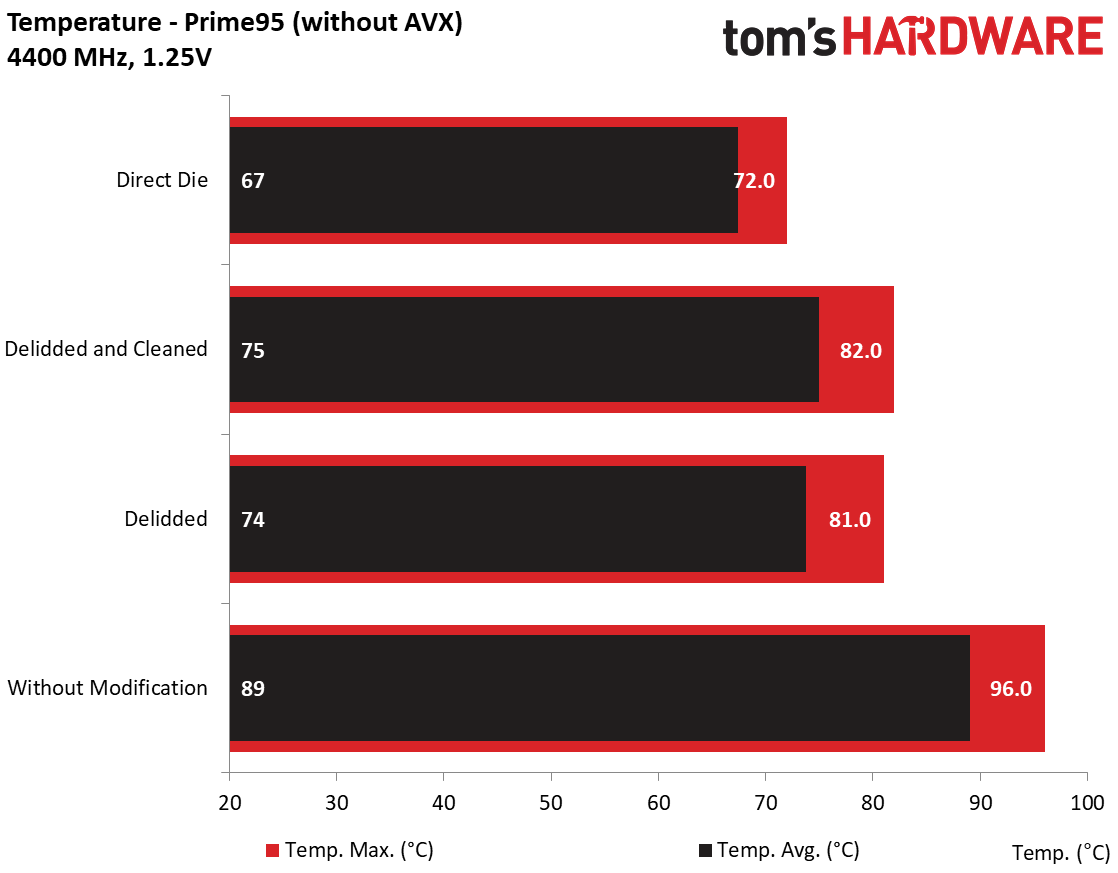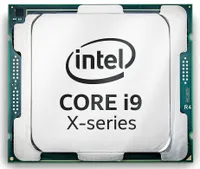Overclocking Intel's Core i9-7900X CPU Up to 5.8 GHz
Temperatures: Stock Vs. Delidded Vs. Direct Die Cooling
With our platform built and the components prepared, it was time to quantify the thermal differences between delidding a CPU and replacing its thermal paste, and cooling the die directly. In each of the following charts, Without Modification means that no changes were made to the CPU; it's a stock sample. Delidded indicates that the processor's integrated heat spreader was removed and then replaced after using higher-quality thermal paste. Delidded and Cleaned means that we also took the time to remove Intel's adhesive residue, in addition to replacing its thermal compound with better stuff from our lab. Of course, the Direct Die entry corresponds to removing the IHS and mounting our thermal solution on the die itself.
Establishing A Baseline
For our first pass, we stuck with default settings and tested the processor using three workloads. Cinebench R15 is one of the most common benchmarks for quantifying the effect of an overclock. It can utilize one core or all of them, and it's incredibly easy to run. We specified a static clock rate of 4000 MHz and dialed in a 1.06V supply voltage. Those parameters should be easily attainable by anyone.
As expected, the stock CPU with no modifications posted the highest temperatures. Delidding helped shave off 5 to 6°C on average, and cooling the die directly helps even more.
Prime95 v.26.6 does not utilize AVX instructions. But it's still one of the most taxing workloads you can hit a CPU with.
Our Core i9-7900X continued operating at 4000 MHz at 1.06V. Not surprisingly, the finishing order remains the same, though the impact of more effective cooling is amplified.
Switching over to Prime95 v.29.1 adds AVX instructions to the mix. The brutality of this workload automatically forced our CPU down to 3600 MHz at 1.0V (due to our CPU ratio offset of -4). But despite the more taxing benchmark, less aggressive clock rates and voltages lead to slightly lower temperatures than the preceding run without AVX support.
If we stopped benchmarking right there and had to draw a conclusion based on these results, we'd recommend leaving your Core i9 alone. The risk of damaging a $1000 CPU, voiding its warranty, and sinking money into extras like the delidding tool just aren't worth a slightly lower operating temperature. However, the gains become more significant once you start overclocking to higher frequencies.
Get Tom's Hardware's best news and in-depth reviews, straight to your inbox.
The Impact of Overclocking
Next, we ran the same three workloads using higher clock rates and voltages. In our pursuit, we sought settings that put our chip's temperature as close to 100°C as possible.
In Cinebench R15, that meant a frequency of 4400 MHz at 1.25V. The overclock imposed significantly warmer temperatures, which increased from 46 to 75°C out of the box. And the delta grew as we improved the configuration's ability to dissipate heat quickly.
With or without adhesive, delidding facilitated gains of 11 to 12°C on average, but also reduced the hottest core's temperature by 15°C. Direct-die cooling helped even more, yielding an 18°C drop compared to the manufacturer’s stock heat sink and fan.
We used the same settings in Prime95 v.26.6 (without AVX), and were treated to significantly warmer temperatures. One core even got as hot as 96°C (never mind our high-performance water cooler and fairly modest 1.25V voltage setting). This is where we realized the benefit of delidding: gains of 15°C after replacing Intel's stock thermal paste and 22°C thanks to the Direct Die Frame are huge.
We had to lower the clock rate and voltage significantly under Prime95 v.29.1. At 4100 MHz and 1.15V, it was already getting worryingly close to our 100°C target. While executing AVX instructions is known to impose warmer temperatures, we've never seen anything like this. And the Core i9-7900X only has 10 cores. Just imagine the 18-core Core i9-7980XE!
MORE: Best CPUs
MORE: Intel & AMD Processor Hierarchy
MORE: All CPUs Content
Current page: Temperatures: Stock Vs. Delidded Vs. Direct Die Cooling
Prev Page Installing The Direct Die Frame Next Page Overclocking: Frequency, Power, And Temperature Scaling-
vasras Another excellent article, with temp, power and voltage scaling at various cooling/contact methods. Thank you.Reply -
Reynod I bet crashman is spewing he didn't get this gig ... :) Well done ... nice work PresencePC!!Reply -
AgentLozen Very interesting article. I liked your explanations of the expert bios settings on the first page. I usually just ignore the stuff in the bios I don't understand.Reply
While I enjoyed reading all of this, it's not something that would help me personally. I leave my CPU underclocked to >1Ghz so I can feel like I'm back in the 90's again. -
10tacle Besides the obvious awesome overclock detail story and results, I like the fact articles remind us of Intel's failure to use the highest quality manufacturing/assembly principles on their top tier CPUs. Especially their x-Series chipsets. There is no excuse for a near-$1,000 chip to have such poor thermal management quality from the factory. I mean how stupid is that.Reply
One of Intel's strongest advantages over AMD for many years now has been their overclocking ability to push them beyond comparable AMD chips. But not only that, to allow future overclocking headroom for keeping the platform longer when newer and faster replacement generation chipsets are introduced. Poor thermals remove those advantages and not many people want to risk messing up their four-figure chip by de-lidding mods.
I hope Intel takes articles like these in notice and will step it up for their next generation of high end i7 and i9 models. -
g-unit1111 Reply21039131 said:Why didn't you just use the EVGA Dark?
I'm guessing because the RAM limit is only 64GB? Where every other X299 board the limit is 128GB. That would make a huge difference in getting the higher speeds. -
Giroro I don't know much about extreme overclocking, tell me more about this "cooling pot".Reply
It is there to hold the liquid nitrogen and separate it from the die? Is there a reason you don't submerge the entire die in liquid nitrogen instead and lose the thermal compound entirely?
It looks like it has a significant copper plate on it. If you are already going through such extreme lengths, then why not use silver and make the plate as thin as possible?
Also, it's pretty interesting that cleaning the processor did not help with the delid, considering that people delidding older i5/i7s say the thickness of that glue is the primary reason that a delid is effective. -
AgentLozen ReplyGiroro said:it's pretty interesting that cleaning the processor did not help with the delid
I thought the same thing. I was expecting the processor to benefit from the cleaning. -
Giroro Reply21039536 said:Besides the obvious awesome overclock detail story and results, I like the fact articles remind us of Intel's failure to use the highest quality manufacturing/assembly principles on their top tier CPUs. Especially their x-Series chipsets. There is no excuse for a near-$1,000 chip to have such poor thermal management quality from the factory. I mean how stupid is that.
One of Intel's strongest advantages over AMD for many years now has been their overclocking ability to push them beyond comparable AMD chips. But not only that, to allow future overclocking headroom for keeping the platform longer when newer and faster replacement generation chipsets are introduced. Poor thermals remove those advantages and not many people want to risk messing up their four-figure chip by de-lidding mods.
I hope Intel takes articles like these in notice and will step it up for their next generation of high end i7 and i9 models.
The cynic in me makes me think that the primary reason Intel switched to thermal paste is for planned-obsolescence and to prevent people from using old platforms for a long time. I'm pretty sure Intel wants to sell you a new processor as often as possible.
Cheaper manufacturing, reduced ability to overclock, Thermal paste that will probably dry out and slow down the CPU within a few years (which will make new models look faster by comparison) ... All these things are positives to a marketing executive.
Hopefully AMD becomes even more competitive, because workmanship isn't going to improve until Intel can correlate their drop in quality with a loss of profit. -
cryoburner Reply
Isn't that the point? If someone messes up their CPU, they have to buy a new one. And delidding voids the warranty, helping Intel more easily recognize and avoid paying for the replacement of chips that have failed as a result of high overclocks. And of course, if people are deterred from overclocking their CPU, they may have more reason to upgrade to a faster one a few years down the line. Intel doesn't want people "keeping the platform longer", and they know that those looking for the highest overclocks will currently go with them either way. Considering it can cost around $5 or so extra to solder a CPU, and most people won't be overclocking, they undoubtedly don't see much point in spending the money to do so.21039536 said:Poor thermals remove those advantages and not many people want to risk messing up their four-figure chip by de-lidding mods.
AMD is willing to, since they currently can't achieve quite the same level of clock rates on their CPUs at the high-end, and know they need to do other things to make their chips more competitive with the market leader, like adding extra cores and using solder.
